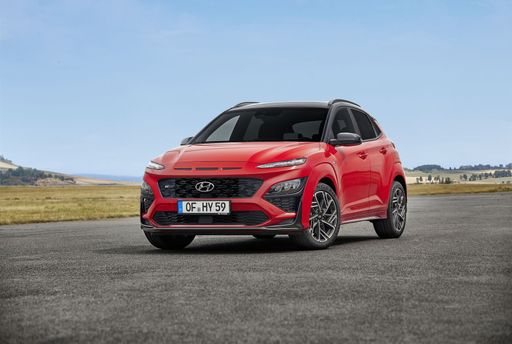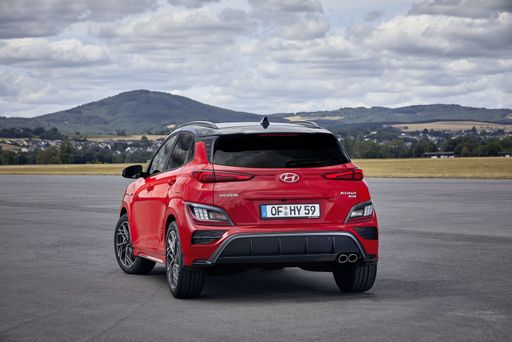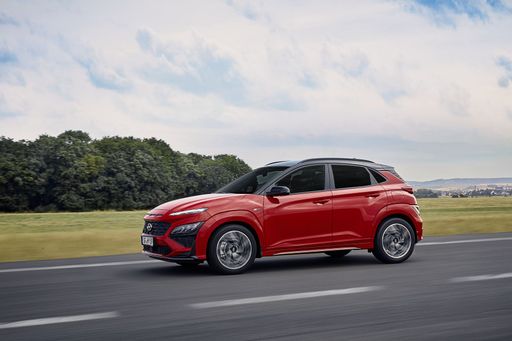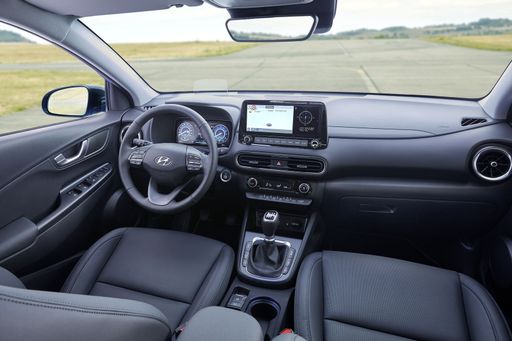Hyundai Kona vs SERES 5 – Differences & prices compared
Compare performance, boot space, consumption and price in one view.
Find out now: which car is the better choice for you – Hyundai Kona or SERES 5?
The Hyundai Kona (SUV) comes with a Electric, Petrol or Full Hybrid engine and Automatic or Manuel transmission. In comparison, the SERES 5 (SUV) features a Electric engine with Automatic transmission.
When it comes to boot capacity, the Hyundai Kona offers 466 L, while the SERES 5 provides 367 L – depending on how much space you need. If you’re looking for more power, decide whether the 218 HP of the Hyundai Kona or the 585 HP of the SERES 5 suits your needs better.
In terms of consumption, the values are 14.60 kWh4.60 L per 100 km for the Hyundai Kona, and 18.60 kWh for the SERES 5.
Price-wise, the Hyundai Kona starts at 23100 £, while the SERES 5 is available from 57300 £. Compare all the details and find out which model fits your lifestyle best!
Hyundai Kona
The Hyundai Kona blends a bold design with a versatile interior, making it a standout choice in the compact SUV market. Its crisp handling and responsive steering provide an engaging driving experience, whether in the city or on the open road. The vehicle also offers a range of features designed to enhance comfort and connectivity, ensuring a pleasurable journey for both driver and passengers.
details @ hyundai.news
@ hyundai.news
 @ hyundai.news
@ hyundai.news
 @ hyundai.news
@ hyundai.news
 @ hyundai.news
@ hyundai.news
SERES 5
The latest iteration of the Model 5 showcases a refined design that seamlessly blends elegance with sportiness. Its spacious interior and cutting-edge technology make it a top choice for drivers seeking both comfort and performance. With impressive efficiency and a commitment to sustainability, the Model 5 sets a new standard in the electric vehicle market.
details

|
|
|
|
|
Costs and Consumption |
|
|---|---|
|
Price
23100 - 41600 £
|
Price
57300 £
|
|
Consumption L/100km
4.6 - 7 L
|
Consumption L/100km
-
|
|
Consumption kWh/100km
14.6 - 16.8 kWh
|
Consumption kWh/100km
18.60 kWh
|
|
Electric Range
377 - 514 km
|
Electric Range
430 km
|
|
Battery Capacity
1.3 - 65.4 kWh
|
Battery Capacity
-
|
|
co2
0 - 163 g/km
|
co2
0 g/km
|
|
Fuel tank capacity
38 - 47 L
|
Fuel tank capacity
-
|
Dimensions and Body |
|
|---|---|
|
Body Type
SUV
|
Body Type
SUV
|
|
Seats
5
|
Seats
5
|
|
Doors
5
|
Doors
5
|
|
Curb weight
1370 - 1773 kg
|
Curb weight
2360 kg
|
|
Trunk capacity
466 L
|
Trunk capacity
367 L
|
|
Length
4350 - 4385 mm
|
Length
4700 mm
|
|
Width
1825 mm
|
Width
1930 mm
|
|
Height
1580 - 1585 mm
|
Height
1625 mm
|
|
Payload
420 - 490 kg
|
Payload
375 kg
|
Engine and Performance |
|
|---|---|
|
Engine Type
Electric, Petrol, Full Hybrid
|
Engine Type
Electric
|
|
Transmission
Automatic, Manuel
|
Transmission
Automatic
|
|
Transmission Detail
Manual Gearbox, Dual-Clutch Automatic
|
Transmission Detail
Reduction Gearbox
|
|
Drive Type
Front-Wheel Drive, All-Wheel Drive
|
Drive Type
All-Wheel Drive
|
|
Power HP
115 - 218 HP
|
Power HP
585 HP
|
|
Acceleration 0-100km/h
7.8 - 11.9 s
|
Acceleration 0-100km/h
4.10 s
|
|
Max Speed
162 - 210 km/h
|
Max Speed
200 km/h
|
|
Torque
200 - 265 Nm
|
Torque
940 Nm
|
|
Number of Cylinders
3 - 4
|
Number of Cylinders
-
|
|
Power kW
85 - 160 kW
|
Power kW
430 kW
|
|
Engine capacity
998 - 1598 cm3
|
Engine capacity
-
|
General |
|
|---|---|
|
Model Year
2024 - 2025
|
Model Year
2024
|
|
CO2 Efficiency Class
A, D, C, E, F
|
CO2 Efficiency Class
A
|
|
Brand
Hyundai
|
Brand
SERES
|
Hyundai Kona
The Hyundai Kona: A Comprehensive Overview
The Hyundai Kona has established itself as a standout in the compact SUV segment, blending innovation with performance and style. As the automotive world moves towards more sustainable and efficient options, the Kona offers a variety of powertrains, from traditional petrol engines to full hybrids and all-electric models.
Powertrain Options and Performance
The Hyundai Kona's powertrain choices cater to a wide range of preferences. For petrol enthusiasts, the Kona offers a 1.0L T-GDI engine, delivering 100 PS, and a more robust 1.6L T-GDI variant with up to 170 PS. Those looking for efficiency without sacrificing power can consider the full hybrid model, offering 129 PS and an impressive consumption of 4.5 L/100km.
For a greener option, the all-electric Kona provides a compelling case. With battery capacities of up to 65.4 kWh, the electric Kona offers power outputs of 156 to 218 PS, and efficiencies as low as 14.6 kWh/100km, enabling an electric range of up to 513 km.
Technical Specifications and Innovations
Built on a robust platform, the Kona delivers versatility and reliability. With a choice between manual or dual-clutch automatic gearboxes, along with options for front-wheel or all-wheel drive, the Kona ensures a tailored driving experience. The handling is enhanced by the car's lightweight construction, balancing a 1370 to 1773 kg curb weight with dynamic performance.
The Kona's design doesn't compromise cargo space for style; it offers a generous 466 L boot capacity. With a relatively compact body, measuring 4350 to 4385 mm in length, the Kona easily navigates urban environments while still commanding a strong road presence with its 1825 mm width.
Efficiency and Eco-Friendliness
Hyundai is committed to reducing emissions, as evidenced by the Kona's CO2 efficiency ratings, which range from class A for electric models to class D for some higher-performance petrol variants. The focus on reducing environmental impact without sacrificing driving pleasure is notable throughout the Kona range.
Costing and Value
The Hyundai Kona offers commendable value for money. Pricing starts at €26,400 and reaches up to €50,690, depending on the chosen configuration. The monthly running costs range from €956 to €1090, with a cost per kilometre of 38.3 to 43.6 cents, making it a competitive option in its class.
Conclusion: Modern, Efficient, and Versatile
The Hyundai Kona stands as a testament to Hyundai's commitment to innovation, efficiency, and practicality. Whether you are inclined towards a traditional combustion engine, a hybrid for a balance of power and efficiency, or a full electric model for maximum eco-friendliness, the Kona provides a tailored solution for each unique driver preference.
SERES 5
The automotive world is consistently evolving, and one of the standout models making waves in 2024 is the SERES 5, an all-electric SUV that epitomizes innovation, power, and efficiency. Designed for those who crave performance without compromising sustainability, the SERES 5 sets a benchmark in the electric vehicle realm.
Technical Specifications at a Glance
The SERES 5 boasts impressive specifications that highlight its engineering prowess. With a powerful electric engine generating a whopping 646 HP and 940 Nm of torque, this SUV demonstrates that electric vehicles can deliver exhilarating performance. Its all-wheel-drive system ensures optimal traction and handling, making it versatile for both urban and off-road adventures.
Performance That Excites
Acceleration is a key performance metric, and the SERES 5 does not disappoint. It can rocket from 0 to 100 km/h in just 4.1 seconds, putting many traditional sports cars to shame. Coupled with a top speed of 200 km/h, it redefines what an electric SUV can achieve on the road.
Efficiency Meets Range
Efficiency is a cornerstone of the SERES 5’s design. With an energy consumption rating of just 18.6 kWh per 100 km, this vehicle is not only powerful but also economical. Moreover, it offers an electric range of 430 km on a single charge, significantly reducing range anxiety for drivers keen on long journeys.
Sleek Design and Comfort
The design of the SERES 5 is as eye-catching as its performance metrics. With dimensions of 4700 mm in length, 1930 mm in width, and 1625 mm in height, this SUV is spacious and robust. It can comfortably seat five passengers, making it an excellent choice for families or groups. Additionally, the trunk capacity of 367 liters provides ample space for luggage or other cargo.
Innovative Features
The 2024 model year introduces several noteworthy innovations. The SERES 5 is equipped with advanced driver-assistance systems that enhance safety and driving experience. Furthermore, it features an intuitive infotainment system that keeps drivers connected and enables smart features at their fingertips.
Environmentally Friendly
With a CO2 emissions rating of 0 g/km, the SERES 5 operates under the highest environmental efficiency class, A. It underscores SERES's commitment to sustainable transportation, showcasing that a high-performance vehicle doesn't have to leave a heavy carbon footprint.
Conclusion
The SERES 5 is a clear representation of where the future of automobiles is headed. Combining high performance, innovative technology, and eco-friendliness, it stands out in a crowded market. For those seeking an electric SUV that offers thrilling driving dynamics without compromising on practicality, the SERES 5 is an enticing option that promises excitement on every journey.
Which drive types are available for the Hyundai Kona?
Available as Front-Wheel Drive or All-Wheel Drive.
The prices and data displayed are estimates based on German list prices and may vary by country. This information is not legally binding.
